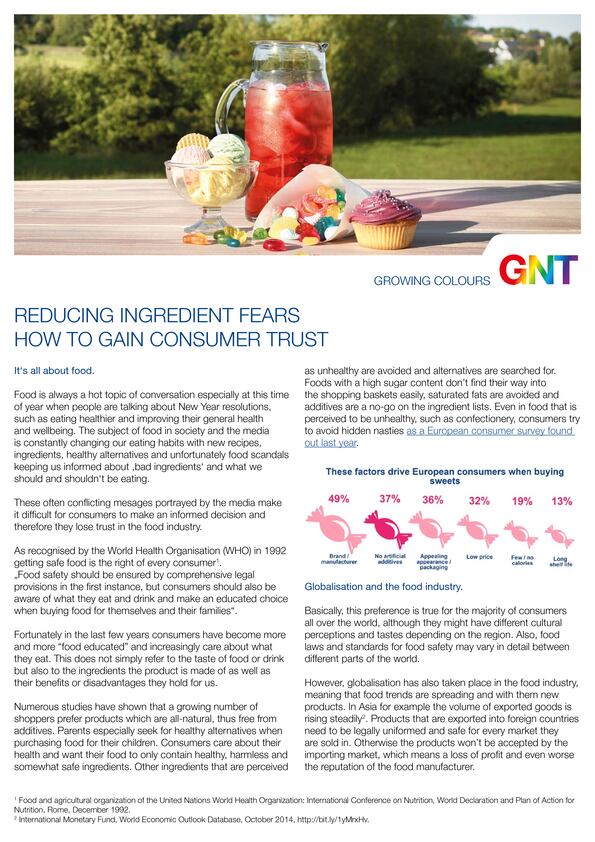California’s decision to ban Red Dye No. 3 (Red-3) will have sweeping consequences for food and beverage manufacturers in the US.
Red-3 has long been a popular option because of the intensely bright pink and cherry red hues it delivers. It is particularly suitable for applications such as frosting and sprinkles, gummies, hard-panned candy, nutritional shakes, protein drinks, and other beverages with a high-pH or a long shelf life.
The ban comes into effect in 2027 and leaves brands that use it facing challenges on several fronts. These include product reformulation, modification of labels and marketing strategies, additional costs associated with manufacturing processes, new ingredient sourcing and discarding of existing stock, investment in regulatory compliance and R&D, supply chain adjustments, and public relations challenges.
Yet even with these challenges, the impending ban enables brands to turn a setback into a positive. By transitioning to plant-based colors, brands have a prime opportunity to demonstrate a commitment to consumer wellbeing and deliver the feel-good storyline that today’s consumers crave.
Tap into the clean-label trend
Today’s consumers are increasingly conscious of the ingredients they consume and their impact on health. A 2023 survey of US consumers carried out by FMCG Gurus shows:1
- 45% say they seek out natural food and drink products
- 38% say they seek out food and drink products that contain recognizable ingredients
- 56% say it is important that coloring used in food and drink is natural
Plant-based colors can deliver an effective replacement for Red-3 while meeting consumer demand for natural products. Manufacturers can even use natural red and pink shades made from fruits, vegetables, and plants that are created based on the concept of coloring food with food. These edible concentrates are made from well-known raw materials such as red potato, purple sweet potato, black carrot, and blackcurrant. They are also processed without chemical solvents using familiar methods such as pressing, chopping, and boiling.
This ensures they qualify for cleaner and clearer label declarations. Red and pink shades can be described on the ingredient list either as ‘fruit and/or vegetable juice for color’ or broken down into the specific raw materials such as ‘carrot juice for color’. They also allow for front-of-pack ‘colored with fruit & vegetables’ logos to help promote consumer understanding and provide instant reassurance. FMCG Gurus research shows 63% of US consumers find the idea of colors made from the concentrated juice of fruit, vegetables, and plants appealing.2
Tell your authentic story
For decades, consumers have become accustomed to the eye-catching shades that Red-3 delivers. Achieving the same radiancy using plant-based reds can be more challenging, if not impossible for some applications. But they can still deliver bright, attractive shades and, even if they are less radiant, it creates a talking point for brands to highlight their pivot away from artificial colors.
Talking about the move to plant-based red colors lets consumers know that your brand prioritizes their wellbeing. Authentic stories resonate with modern shoppers and transparent communication is key. Brands can openly promote the fact that while plant-based reds might not deliver quite the same vibrancy, their colors are now made from fruits, vegetables, and plants.
They can also tell stories about how the plant-based colors are created, from how the crops are grown to the manufacturing processes involved. This can connect with consumers on a deeper level and foster long-term relationships built on a foundation of trust and reliability. Collaborating with influencers, nutritionists, and environmental experts can also amplify the message and build a stronger understanding and a sense of brand loyalty.
To make the most of this opportunity, brands should invest in consumer education, too. In 1990, the Food & Drug Administration (FDA) banned Red-3 in cosmetics due to concerns about its potential carcinogenicity based on animal studies.3 A 2021 report from the California Environmental Protection Agency (CalEPA) on Red-3 and other synthetic food dyes found that they may result in hyperactivity and other neurobehavioral problems in some children. The report also found that common exposures to Red No. 3 from a few foods may exceed acceptable daily intake levels.4 By sharing information around this and the benefits of plant-based reds, consumers are empowered to make informed choices.
Embracing the possibilities with plant-based colors
Plant-based colors are widely used around the world to deliver bright reds and pinks in applications including confectionery, cereals, baked goods and frostings, and low-pH beverages and syrups.
Nonetheless, they are not a plug-and-play solution and there is a significant amount of work to be done on process implementation when switching from synthetic dyes. Technical considerations like processing conditions and pH should be considered. Tests must be carried out on stability, stress and organoleptic impact among others. As such, it is vital to work with a knowledgeable supplier that can provide effective solutions for different project requirements.
The Red-3 ban presents new challenges for manufacturers and might feel overwhelming right now, but the reality is that artificial colors can significantly limit a products appeal. It therefore presents an incredible opportunity for forward-thinking brands. By embracing clean-label, plant-based red shades, it’s possible to tell a compelling story about your commitment to natural, healthier products and build a strong connection with your audience.
References
1. FMCG Gurus. (2023). Clean Label Trends in the USA.
2. FMCG Gurus. (2023). Clean Label & Naturalness – USA.
3. FDA. (February 1990). Color Additives; Denial of Petition for Listing of FD&C Red No. 3 for Use in Cosmetics and Externally Applied Drugs; Withdrawal of Petition for Use in Cosmetics Intended for Use in the Area of the Eye.
4. California Office of Environmental Health Hazard Assessment. (2021). Report Links Synthetic Food Dyes to Hyperactivity and other Neurobehavioral Effects in Children.




